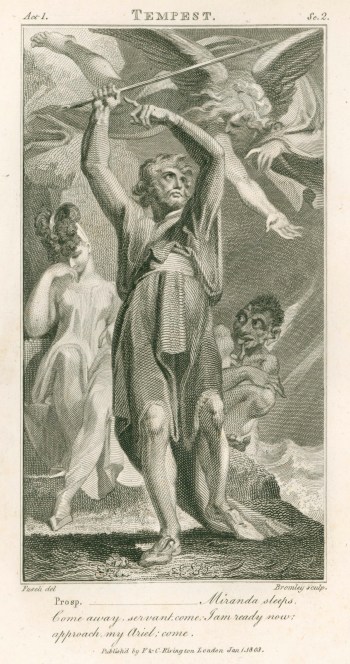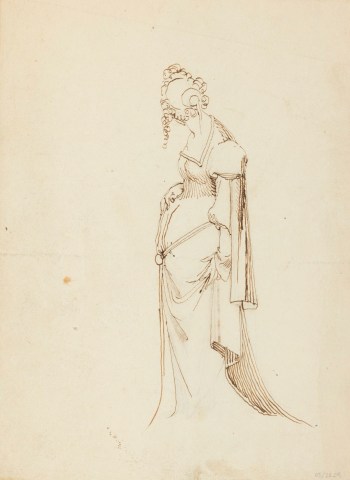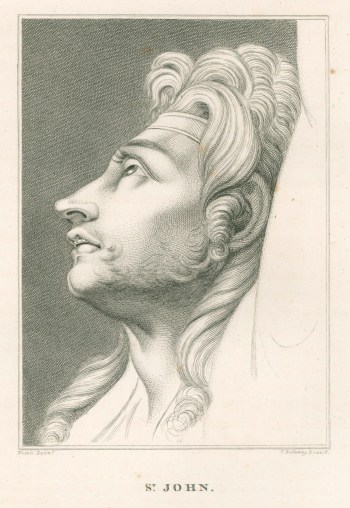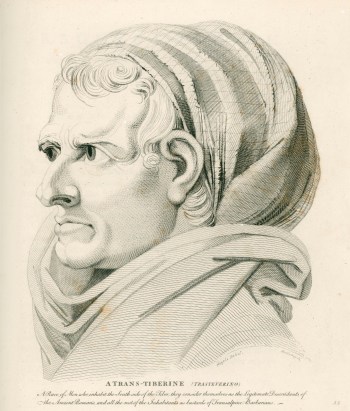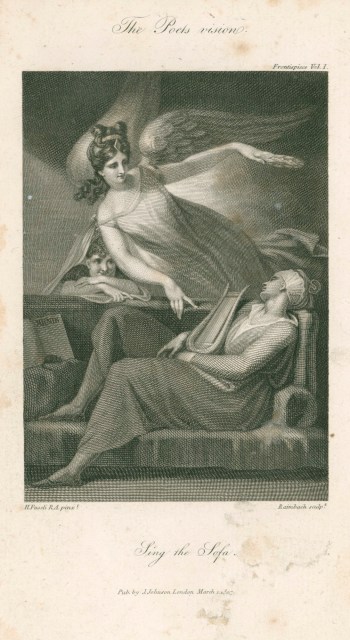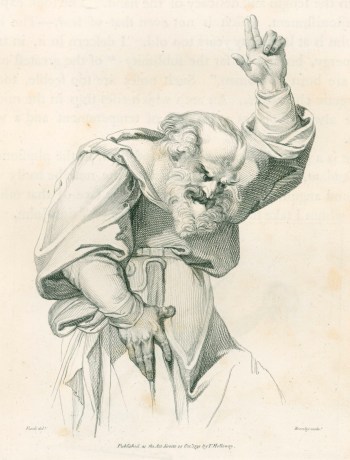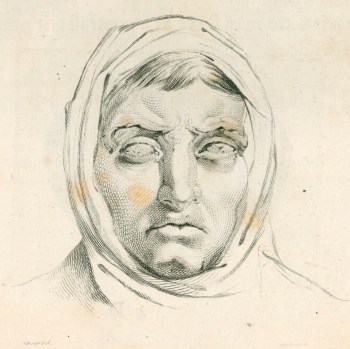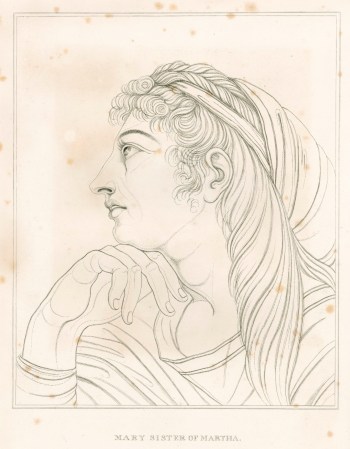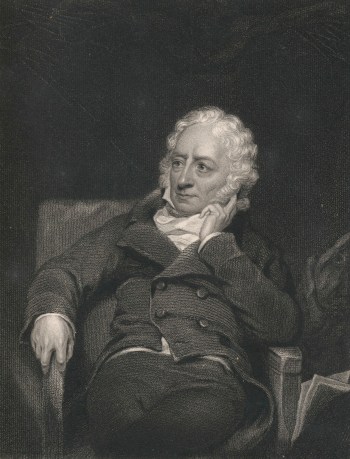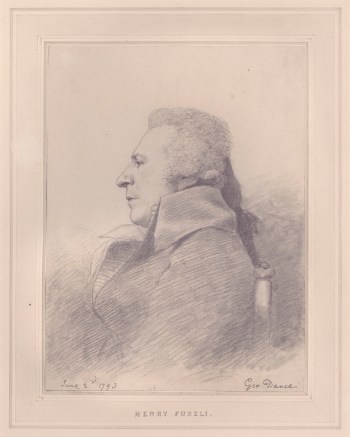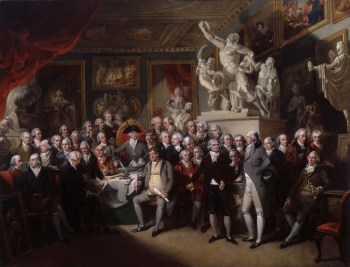Henry Fuseli RA (1741 - 1825)
RA Collection: People and Organisations
A Swiss artist known for fantastical paintings inspired by classic literature, Henry Fuseli served as Keeper of the RA Schools for 21 years. He was a friend of William Blake, who made engravings of several of his works. Fuseli oversaw the education of many students in the RA Schools including John Constable, Benjamin Haydon, William Etty, and Edwin Landseer.
Henry Fuseli was born Henry Füssli in Zurich, Switzerland. The son of a painter and author Johann Caspar Füssli, Fuseli showed an interest in art at a young age, but his father persuaded him to become a minister. He completed his training and was ordained in 1761, but abandoned the priesthood soon after.
In 1764 Fuseli travelled to London, where he met the Royal Academy’s first President, Sir Joshua Reynolds, who encouraged his artistic ambitions. Between 1770 and 1778 Fuseli studied and worked in Rome—where he italianised his name to Fuseli. After a short stay in Zurich he returned to London in 1779.
Fuseli’s best-known work, The Nightmare, was first exhibited at the Royal Academy’s Summer Exhibition in 1782. Depicting a woman asleep with a malevolent imp crouched on her chest, the painting is characteristic of Fuseli’s imaginative style. In 1783 an engraving was made of the work, which helped to popularise the image and encouraged Fuseli to continue painting variations on this theme.
Throughout the 1780s and 1790s, Fuseli was commissioned by the publisher John Boydell to paint scenes from Shakespeare’s plays for Boydell’s short-lived Shakespeare Gallery, which opened in London in 1789. Fuseli had at least nine works exhibited in the gallery, depicting scenes from plays including Macbeth, A Midsummer Night’s Dream and King Lear. Inspired by this venture, Fuseli began work on a series depicting scenes from John Milton’s Paradise Lost and opened his own Milton Gallery to exhibit them in 1799. Both galleries aimed to profit from selling prints of the works on display, but failed to generate enough income and closed in the early 1800s.
Fuseli was elected an Associate of the Royal Academy in 1788 and a full Academician in 1790. His Diploma Work (given to the RA on his election) depicts a scene from Nordic mythology, Thor Battering the Midgard Serpent.
Fuseli served as Professor of Painting at the Royal Academy Schools between 1799-1805, and 1810-1825 and was also Keeper of the Schools from 1804 until his death in 1825.
RA Collections Decolonial Research Project - Extended Case Study
Henry Fuseli was an intellectual who moved in the elite literary and artistic circles of his day. Despite his radical ideals, he also developed friendships with individuals whose wealth and status were dependent upon colonial exploitation. On moving to London in 1764, one of Fuseli’s first contacts and long-term supporters in London was the banker, Thomas Coutts (1735–1822). The Coutts family, originally from Montrose in Scotland, partly derived its wealth from tobacco plantations in Virginia (see Notes, 1 and 2). It was Thomas Coutts who funded Fuseli’s journey to Rome in 1770, where he resided until 1777, a very important period for his artistic and intellectual development.
Many of Fuseli’s close friends and patrons, however, were progressive intellectuals who espoused anti-slavery views and, in some cases, actively campaigned for abolition. One of his closest associates in London was the radical bookseller and publisher Joseph Johnson (1738–1809), who promoted books opposing enslavement and supporting religious tolerance and the rights of women. Johnson notably organised the publication of Olaudah Equiano’s autobiography, The Interesting Narrative of the Life of Olaudah Equiano (1789) – a memoir by a formerly enslaved Black African living in Britain that was also a treatise against the evils of enslavement.
Another key patron and ally of Fuseli was Robert Smyth, fifth Baronet (1744–1802), whom he met during his years in Rome in the 1770s. Smyth, a radical with anti-monarchist and pro-revolutionary views, became Fuseli’s principal patron during his Rome period and in the following years when he returned to London.
In the late 1790s, Fuseli was supported financially by William Roscoe (1753–1831), the Liverpool-born anti-slavery campaigner, banker, lawyer and patron of the arts who authored many anti-slavery writings. Among these, he published The Wrongs of Africa (1787-8), a multi-volume poem, the profits from which he offered to the newly formed Abolition Committee in parliament (see Notes, 3). Fuseli was also partly responsible for Roscoe’s enthusiasm for Italian art, encouraged through their friendship after the former returned from Rome.
The following paragraph refers to an artwork and a poem that use offensive language in their titles. We have kept the original wording to preserve its historical significance.
In 1806-7, Fuseli painted a work making clear his opposition to enslavement, The Negro Avenged (Hamburg Kunsthalle), illustrating William Cowper’s anti-slavery poem The Negro’s Complaint (1788). The work was engraved by Abraham Raimbach in 1807 and published in Poems by William Cowper (1808). The volume circulated widely and the poem and its illustrations became popular with supporters of abolition in Britain. The painting and engraving illustrate a stanza of the poem conveying the idea that the storms and extreme weather that struck British colonies were divine retribution for Britain’s role in enslavement. Fuseli depicts three Black figures in the foreground of the image, two standing on a cliff-edge while a third is seated nearby, looking on. The standing figures look out to the stormy sea beyond. The male figure is dressed in a loincloth with his fists raised in triumph, and the female figure wears a white dress, raising her index finger as if in warning. A wild storm rages around them; in the background a wrecked slave ship is struck by lightning. Fuseli presents the two main figures as defiant protagonists; this proactive show of strength is unusual in abolitionist visual material of the time, which more commonly depicted Black Africans as powerless victims (see Notes, 4).
Notes
- https://www.scotsman.com/whats-on/arts-and-entertainment/scotlands-slave-trade-and-montroses-key-role-1479125 (accessed 1 March 2022).
- https://www.coutts.com/about/history.html (accessed 1 March 2022).
- Ferguson, Moira. “Mary Wollstonecraft and the Problematic of Slavery.” Feminist Review, no. 42 (1992): 82–102. https://doi.org/10.2307/1395131 (accessed 1 March 2022).
- https://collections.vam.ac.uk/item/O127381/the-negro-revenged-print-fuseli-henry/ (accessed 1 March 2022).
Relevant ODNB entries
Weinglass, D. H. “Fuseli, Henry formerly Johann Heinrich Füssli, painter and writer.” Oxford Dictionary of National Biography. 23 Sep. 2004; Accessed 1 Mar. 2022. https://www-oxforddnb-com.lonlib.idm.oclc.org/view/10.1093/ref:odnb/9780198614128.001.0001/odnb-9780198614128-e-10254
Healey, Edna. “Coutts, Thomas (1735–1822), banker.” Oxford Dictionary of National Biography. 23 Sep. 2004; Accessed 1 Mar. 2022. https://www-oxforddnb-com.lonlib.idm.oclc.org/view/10.1093/ref:odnb/9780198614128.001.0001/odnb-9780198614128-e-6469
Hall, Carol. “Johnson, Joseph (1738–1809), bookseller.” Oxford Dictionary of National Biography. 23 Sep. 2004; Accessed 1 Mar. 2022. https://www-oxforddnb-com.lonlib.idm.oclc.org/view/10.1093/ref:odnb/9780198614128.001.0001/odnb-9780198614128-e-14904
Weinglass, D. H. “Smyth, Sir Robert, fifth baronet (1744–1802), patron of the arts and radical.” Oxford Dictionary of National Biography. 23 Sep. 2004; Accessed 1 Mar. 2022. https://www-oxforddnb-com.lonlib.idm.oclc.org/view/10.1093/ref:odnb/9780198614128.001.0001/odnb-9780198614128-e-62976
Macnaughton, Donald A. “Roscoe, William (1753–1831), historian and patron of the arts.” Oxford Dictionary of National Biography. 23 Sep. 2004; Accessed 1 Mar. 2022. https://www-oxforddnb-com.lonlib.idm.oclc.org/view/10.1093/ref:odnb/9780198614128.001.0001/odnb-9780198614128-e-24084
Profile
Born: 6 February 1741 in Zürich, Switzerland
Died: 16 April 1825
Nationality: Swiss
Elected ARA: 3 November 1788
Elected RA: 10 February 1790
Keeper from: 1804 - 1825
Professor of Painting: 1799 - 1805
Professor of Painting: 1810 - 1825
Gender: Male
Preferred media: Painting
Works by Henry Fuseli in the RA Collection
10 results
-
![Henry Fuseli RA, Sketch of a nude male figure in the pose of the Dioscuri]()
Henry Fuseli RA
Sketch of a nude male figure in the pose of the Dioscuri, c.1790
Pen and ink on laid paper
-
![Henry Fuseli RA, Fertilization of Egypt]()
Henry Fuseli RA
Fertilization of Egypt, 1 December 1791
Line-engraving
-
![Henry Fuseli RA, Falstaff at Hearne's Oak: a scene from Shakespeare's Merry Wives of Windsor]()
Henry Fuseli RA
Falstaff at Hearne's Oak: a scene from Shakespeare's Merry Wives of Windsor, 27 January 1803
Etching with engraving
-
![Henry Fuseli RA, Prospero summons Ariel: a scene from Shakespeare's Tempest]()
Henry Fuseli RA
Prospero summons Ariel: a scene from Shakespeare's Tempest, 1 January 1803
Etching with engraving
-
![Henry Fuseli RA, Julia sends away Lucetta: a scene from Shakespeare's Two Gentlemen of Verona]()
Henry Fuseli RA
Julia sends away Lucetta: a scene from Shakespeare's Two Gentlemen of Verona, 8 January 1803
Etching with engraving
-
![Henry Fuseli RA, A woman in 16th century dress]()
Henry Fuseli RA
A woman in 16th century dress, ca. 1803
Pen and brown ink on cream wove paper
-
![Henry Fuseli RA, A man asleep in bed, a female figure in profile stands on the left]()
Henry Fuseli RA
A man asleep in bed, a female figure in profile stands on the left, ca. 1805
Black chalk on off-white laid paper
-
![Henry Fuseli RA, Thor battering the Midgard Serpent]()
Henry Fuseli RA
Thor battering the Midgard Serpent, 1790
Oil on canvas
-
![Henry Fuseli RA, Sleeping woman with a Cupid]()
Henry Fuseli RA
Sleeping woman with a Cupid, 1780-1790
Etching
-
![Henry Fuseli RA, Evening Thou Bringest All (Lady at a window)]()
Henry Fuseli RA
Evening Thou Bringest All (Lady at a window)
Pen lithograph on laid paper
Works after Henry Fuseli in the RA Collection
36 results
-
![Henry Fuseli RA, Rosicrucius's Sepulchre]()
After Henry Fuseli RA
Rosicrucius's Sepulchre, 20 August 1803
Line-engraving
-
![Henry Fuseli RA, The Creation of Eve]()
After Henry Fuseli RA
The Creation of Eve, 1807
Line- and stipple-engraving
-
![Henry Fuseli RA, Aratus the Poet and Urania the Muse of Astronomy]()
After Henry Fuseli RA
Aratus the Poet and Urania the Muse of Astronomy, c.1800
Line engraving
-
![Henry Fuseli RA, The Prison]()
After Henry Fuseli RA
The Prison, 1 March 1807
Etching and engraving
-
![Henry Fuseli RA, The Newspaper in the Country]()
After Henry Fuseli RA
The Newspaper in the Country, 1 March 1807
Etching and engraving
-
![Henry Fuseli RA, Mad Kate]()
After Henry Fuseli RA
Mad Kate, 1 March 1807
Etching and engraving
-
![Henry Fuseli RA, The Negro Revenged]()
After Henry Fuseli RA
The Negro Revenged, 1 March 1807
Etching and engraving
-
![Henry Fuseli RA, A Mother with her Family in the Country]()
After Henry Fuseli RA
A Mother with her Family in the Country, 1 March 1807
Etching and engraving
-
![Henry Fuseli RA, A Dressing Room]()
After Henry Fuseli RA
A Dressing Room, 1 March 1807
Etching and engraving
-
![Henry Fuseli RA, Virtue reclaiming Youth from the arms of Vice]()
After Henry Fuseli RA
Virtue reclaiming Youth from the arms of Vice, 1 March 1807
Etching and engraving
-
![Henry Fuseli RA, Fantasy portrait of Michelangelo before the Roman Coliseum]()
After Henry Fuseli RA
Fantasy portrait of Michelangelo before the Roman Coliseum, 1801
Etching with engraving
-
![Henry Fuseli RA, Silence]()
After Henry Fuseli RA
Silence, 1801
Etching with engraving
-
![Henry Fuseli RA, Crossed Man's and Woman's Hands]()
After Henry Fuseli RA
Crossed Man's and Woman's Hands, May 1797
Etching with engraving
-
![Henry Fuseli RA, Woman's hand and arm with a bracelet]()
After Henry Fuseli RA
Woman's hand and arm with a bracelet, May 1797
Etching with engraving
-
![Henry Fuseli RA, Seated muscular male nude]()
After Henry Fuseli RA
Seated muscular male nude, September 1793
Etching with engraving
-
![Henry Fuseli RA, Sibyl with Open Book in her Lap]()
After Henry Fuseli RA
Sibyl with Open Book in her Lap, April 1793
Etching with engraving
-
![Henry Fuseli RA, Young Man sitting beneath a Tree]()
After Henry Fuseli RA
Young Man sitting beneath a Tree, July 1792
Etching with engraving
-
![Henry Fuseli RA, Martha Hess]()
After Henry Fuseli RA
Martha Hess, December 1791
Etching with engraving
-
![Henry Fuseli RA, Rechab displaying the Head of Ishbosheth]()
After Henry Fuseli RA
Rechab displaying the Head of Ishbosheth, December 1791
Etching with engraving
-
![Henry Fuseli RA, Three Heads of Damned Souls from Dante's Inferno]()
After Henry Fuseli RA
Three Heads of Damned Souls from Dante's Inferno, December 1791
Etching with engraving
-
![Henry Fuseli RA, Youth sitting beneath a Tree in a Pastoral Landscape]()
After Henry Fuseli RA
Youth sitting beneath a Tree in a Pastoral Landscape, December 1791
Etching with engraving
-
![Henry Fuseli RA, The Witch of Endor summoning up the spirit of Samel]()
After Henry Fuseli RA
The Witch of Endor summoning up the spirit of Samel, December 1791
Etching with engraving
-
![Henry Fuseli RA, The Escapee: A Real Scene in the Hospital of san Spirito at Rome]()
After Henry Fuseli RA
The Escapee: A Real Scene in the Hospital of san Spirito at Rome, December 1791
Etching with engraving
-
![Henry Fuseli RA, Balaam blessing the Children of Israel]()
After Henry Fuseli RA
Balaam blessing the Children of Israel, December 1791
Etching with engraving
-
![Henry Fuseli RA, Cain]()
After Henry Fuseli RA
Cain, December 1791
Etching with engraving
-
![Henry Fuseli RA, The Death of Abel]()
After Henry Fuseli RA
The Death of Abel, December 1791
Etching with engraving
-
![Henry Fuseli RA, St. John]()
After Henry Fuseli RA
St. John, March 1791
Etching with engraving
-
![Henry Fuseli RA, Brutus]()
After Henry Fuseli RA
Brutus, December 1791
Etching with engraving
-
![Henry Fuseli RA, A Trans-Tiberine]()
After Henry Fuseli RA
A Trans-Tiberine, December 1789
Etching with engraving
-
![Henry Fuseli RA, The Daughter of Herodias]()
After Henry Fuseli RA
The Daughter of Herodias, 25 April 1798
Etching with engraving
-
![Henry Fuseli RA, Mary, sister of Martha]()
After Henry Fuseli RA
Mary, sister of Martha, 2 July 1792
Etching with engraving
-
![Henry Fuseli RA, The Poet's Vision]()
After Henry Fuseli RA
The Poet's Vision, 1 March 1807
Etching and engraving
-
![Henry Fuseli RA, Ezzelin Bracciaferro musing over the Body of Meduna]()
After Henry Fuseli RA
Ezzelin Bracciaferro musing over the Body of Meduna, December 1791
Etching with engraving
-
![Henry Fuseli RA, A Patriarch or Prophet]()
After Henry Fuseli RA
A Patriarch or Prophet, December 1791
Etching with engraving
-
![Henry Fuseli RA, Fourth Head of a Damned Soul from Dante's Inferno]()
After Henry Fuseli RA
Fourth Head of a Damned Soul from Dante's Inferno, December 1791
Etching with engraving
-
![Henry Fuseli RA, Mary, sister of Martha]()
After Henry Fuseli RA
Mary, sister of Martha, July 1792
Etching with engraving
Works associated with Henry Fuseli in the RA Collection
7 results
-
![Thomas Holloway, Christ at the Sepulchre: A scene from Raphael]()
Thomas Holloway
Christ at the Sepulchre: A scene from Raphael, December 1791
Etching with engraving
-
![John Corner, Head of Christ]()
John Corner
Head of Christ, December 1791
Etching with engraving
-
![George Henry Harlow, Portrait of Henry Fuseli, R.A.]()
After George Henry Harlow
Portrait of Henry Fuseli, R.A., 1834
Stipple- and line-engraving
-
![Moses Haughton the younger, Portrait of Henry Fuseli RA]()
After Moses Haughton the younger
Portrait of Henry Fuseli RA, 1808
Stipple-engraving
-
![Moses Haughton the younger, Portrait of Henry Fuseli RA]()
After Moses Haughton the younger
Portrait of Henry Fuseli RA
Stipple-engraving
-
![George Dance RA, Portrait of Henry Fuseli, R.A.]()
George Dance RA
Portrait of Henry Fuseli, R.A., 2 June 1793
Pencil and pink chalk on cream wove paper
-
![Henry Singleton, The Royal Academicians in General Assembly]()
Henry Singleton
The Royal Academicians in General Assembly, 1795
Oil on canvas
Associated books
21 results
-
Henry Fuseli RA
Lectures on painting, delivered at The Royal Academy, by Henry Fuseli, P.P. ; with additional observations and notes - London: 1820
04/3301
-
Henry Fuseli RA
The Life And Writings Of Henry Fuseli, Esq. M.A. R.A. Keeper, And Professor Of Painting To The Royal Academy In London; Member Of The First Class Of The Academy Of St. Luke At Rome. The Former Written, And The Latter Edited By John Knowles, F.R.S. Corresponding Member Of The Philosophical Society At Rotterdam, His Executor. In Three Volumes. Vol. I. (-III.) - London:: [1831]
05/3669
-
Henry Fuseli RA
Lectures On Painting, Delivered At The Royal Academy March 1801, By Henry Fuseli, P.P. With Additional Observations And Notes. - London:
03/2265
-
Matthew Pilkington
A Dictionary Of Painters, From The Revival Of The Art To The Present Period; By The Rev. M. Pilkington, A.M. A New Edition, With Considerable Alterations, Additions, An Appendix, And An Index, By Henry Fuseli, R.A. [Epigraph] - London:: 1805.
06/3141



